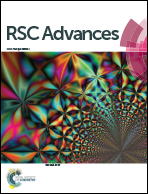New cellulose–silica composite IMAC/C18 for the selective enrichment of phosphorylated molecules and the improved recovery of hydrophilic species†
Abstract
Cellulose and silica are the traditional quality sorbents with a range of reported applications, particularly for hydrophilic biomolecules. With this in mind, cellulose and silica were brought into a composite form to bring their individual benefits on to a single platform. Cellulose and silica were chosen in order to obtain a completely hydrophilic composite, which was then derivatized for the selective enrichment of phosphopeptides and as a desalting material prior to mass spectrometric analysis. The composite was characterized by FT-IR, EDX and SEM. As a material for immobilized metal ion affinity chromatography (IMAC), the cellulose–silica composite enriches phosphopeptides from a complex mixture in which β-casein is spiked in de-phosphorylated HeLa cell extract. The inherent hydrophilic nature of the composite gives a higher selectivity of up to 2000 times the complexity level and sensitivity down to 1 femtomole for phosphopeptides. As well as the immobilized metal ions on the IMAC composite, the roles of the base materials in the composite, i.e. cellulose and silica were also tested in the enrichment which helped thereof in optimizing the best sample preparation protocol. With the introduction of successive elution conditions, phospholipids and phosphopeptides were enriched and identified from egg yolk digest using a single batch extraction method. The phosphopeptides were analyzed with MALDI-MS, whereas the low molecular weight phospholipids were analysed using newly designed gold nanoparticles and carbon based materials through LDI-MS. Phosphopeptides were also enriched from complex serum digest and discussed with relevance to prostate cancer. As a reverse-phase (RP) material, it provides a combination of the hydrophilic composite and the hydrophobic C18 chain. Efficient desalting of higher salt concentrations, improved recovery of hydrophilic peptides and high sequence coverage in comparison to commercial materials makes cellulose–silica C18 a better desalting tool with in-house economical synthesis.



 Please wait while we load your content...
Please wait while we load your content...